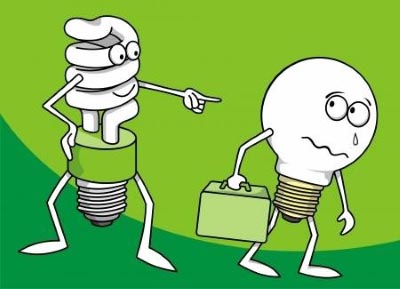Not too long ago, the compact fluorescent lamp was supposed to be the efficient and perhaps dominant lighting source of the future, but that future didn't last long; there's a broader lesson here beyond lighting.

It wasn’t that long ago that compact fluorescent lamps (CFLs) were hailed as the “next big thing” for the foreseeable future of home and office lighting. And they were fairly successful, at least for a short while. Using them made sense, as they saved significant energy compared to incandescent lamps, with efficiency of about 2-5% (about 13-18 lumens per watt) for the latter, versus 7-10% (55-70 lumens per watt, and often more) for the former. They also fit in many existing fixtures (called luminaires in the lighting trade), and while they were more costly to purchase – anywhere from $1 each to several dollars each, compared to around $0.50 to $1 for an incandescent lamp, their longer life and lower total cost of ownership were very strong points in their favor.
But times change and they change quickly, at least where technology is concerned. On a recent visit to local big-box stores – Home Depot and Lowe’s – and small, independent hardware stores, I couldn’t find a single CFL. In their placed were extensive displays of LED-based lamps of all sizes and styles, including the small-base candelabra size. It looks like the window of fame for CFLs came quickly and left even more quickly. (For both, of course, the immediate market drivers were their lower operating costs and longer life (impact on labor cost of replacing) along increasingly stringent world-wide regulatory mandates.
So, what happened? Apparently, several factors conspired to knock CFLs out of the contention box. Among them, the top one is most likely that LEDs reached parity in cost at comparable efficiency, while offering other benefits: more pleasing physical appearance, better color performance and options (color temperature and color rendering index, CRI), and better fit with both existing and new luminaires.
There’s one other area where LEDs soon surpassed CFLs: ease of dimming. Although there are ways to dim CFLS driven directly from the AC line, the added circuitry in the CFL bulb was tricky to implement and IC vendors invested significant effort to make it happen. Worse, the dimmable CFLs had to be dimmer-compatible with the ubiquitous, low-cost TRIAC-based dimmers already installed by the millions in homes. The low-cost, very effective TRIAC-dimming approach based on zero-crossing PWM had to be “mapped” to a CFL-friendly dimming approach. Consumer would be frustrated by CFLs marked as “non-dimmable” on labels they did not see or read, and then be angry when they didn’t work or dim in their installed incandescent socket which used to dim just fine.
A sure sign of the decline of CFLs is the difficulty in finding up-to-date market data. There’s a glowing set of predictions made in 2009 [1], a 2012 report form consultant/market researcher McKinsey & Co [2] and a somewhat prescient 2014 report from the ACEEE Summer Study on Energy Efficiency in Buildings, [3]. After that, numbers on the CFL versus LED market are hard to come by, based on the modest amount of research on studies and reports I did.
Beyond the CFL/LED story, is there a lesson here? First, long-range predictions of the “next big thing” are very risky, as unforeseeable disruptions happen (in the 1950s, it looked as if market for vacuum tubes would booming for the “foreseeable” future), while somewhat foreseeable events, such as the upstaging by LEDs, can take much less or more time than the analysts predict.
Second, what looks “eternal” today is only an illusion. Right now, many are worried about the dominance and reach of Facebook and other web-based entities, and that’s a legitimate concern. But Facebook isn’t necessarily forever. The landscape is littered with the literal and figurative skeletons of companies which had similar dominance and influence in one or many areas such as RCA (or even GE today!), which now exists only as a marketing nameplate owned by a licensing company, see [4].
In other cases, what remains is not a skeleton, but a very different, and far-less dominant company or companies. In the early days of the PC, “opinion leaders” worried that our entire future – maybe forever – would be dominated by a combination of IBM PCs, Intel microprocessors, and the Microsoft operating system. Well, IBM is 100% out of the PC business (desktop and laptop), Intel is still a major force in processors but with far less dominance, and Windows is a strong OS but not the only one, especially in smartphones and embedded applications. As baseball legend and philosopher Yogi Berra supposedly quipped, “Predictions are very hard to make, especially about the future.”
What’s next after LEDs in lighting? I have no idea; perhaps someone out there will make the right prediction. It could be an enhanced version of LEDs, or maybe quantum dots, or some technology we are not even aware of at this time.
Have you seen any recent, credible statistics on CFLs? What’s your perspective on the rise and fall of CFLs versus LEDs, and the bigger lessons it teaches us?